Photocatalytic Coatings Market by Type (TiO2, ZnO), Application (Self-Cleaning, Air Purification, Water Treatment, Anti-fogging), End-use (Building & Construction, Transportation) & Region(North America, Europe, APAC, SA & MEA) - Global Forecast to 2028
The Photocatalytic Coatings market is projected to grow from USD 0.9 billion in 2023 to USD 1.4 billion by 2028, at a CAGR of 9.7% between 2023-2028 respectively. Self-cleaning, de-polluting, and anti-microbial properties to drive the demand in high traffic areas for Photocatalytic Coatings.
Attractive Opportunities in the Photocatalytic Coatings Market
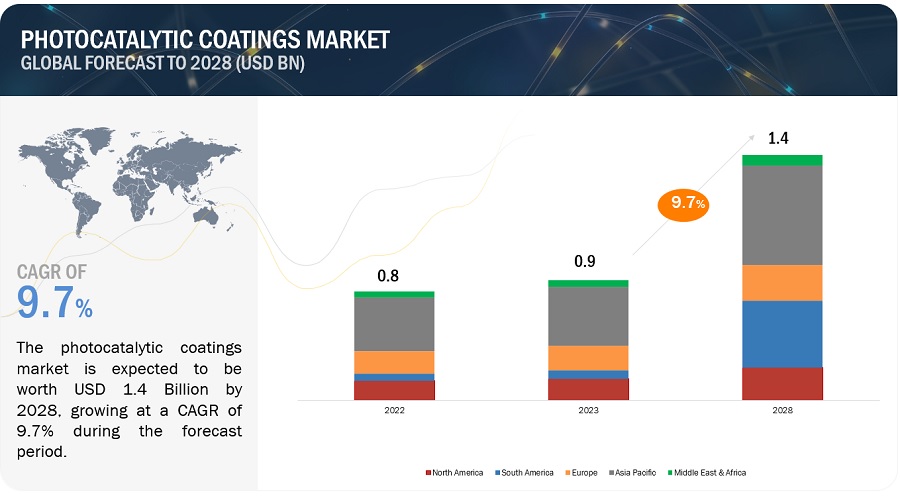
To know about the assumptions considered for the study, Request for Free Sample Report
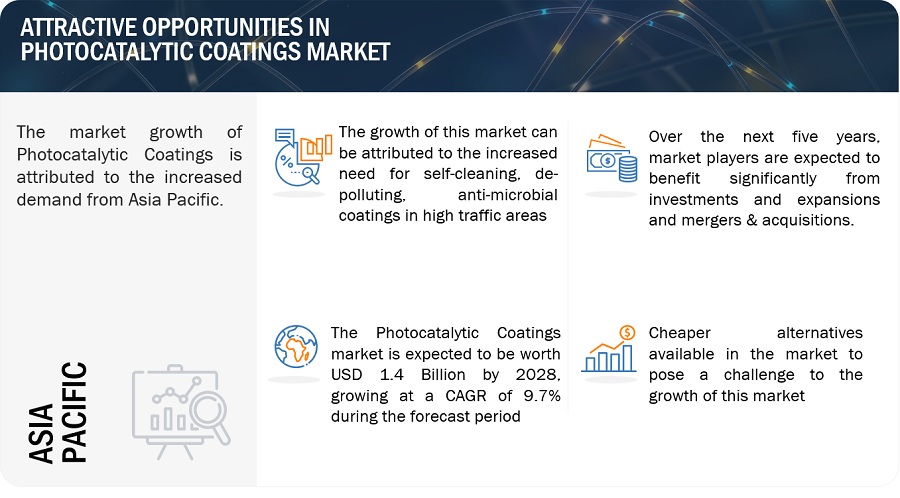
Source: Expert Interviews, Secondary Sources, and MarketsandMarkets Analysis
Market Dynamics
Driver: Low VOC emissions
Indoor air quality is becoming a growing concern for consumers and business owners. Indoor air pollutants (VOCs — volatile organic compounds) can come from sources such as carpets, furnaces, furniture, insulation, pets, refuse and fuels from the garage. Photocatalysts are mainly added in the dispersion form to the coating systems. There are a few water based systems available in the market like low-solids gloss polish, higher solids gloss polish, satin 2K urethane system, etc. A lot of research are ongoing over the water based photocatalytic TiO2 coatings using different compositions. For example, in 2017, the photocatalytic efficiency of TIO2 nanoparticles is tested that are embedded in water-based styrene-acrylic coatings. Color characteristics, photocatalytic behavior, and resistance of the coating materials to VOC emissions and self-degradation was said suitable and can be used for indoor applications, even in the absence of suitable UV stabilizers.
Restraint: Increased cost for photocatalyst activation in a normal interior surface
Nanotechnology plays an important role in manufacturing photocatalytic coatings. This seeks not only to improve the traditional properties of the coating, but it also looks forward to providing conventional coatings with new functionalities, such as self-cleaning, antimicrobial, and air-purifying properties. However, although intensive research has been done during almost 20 years on TiO2 photocatalysis towards the above-mentioned properties, but the current restraint in applying this light-driven technology, have limited its efficiency in in-situ application and lead to increased costs for the users. Therefore, the TiO2 fundamentals in relation to the interior surfaces has main research gaps of the multifunctional properties obtained at the laboratory scale and in pilot projects.
Also, it has been observed that the initial activity of conventional photocatalytic titanium dioxide coatings is poor unless the coating has been pre-activated, such as by washing with water. This additional step makes application of a photocatalytic titanium dioxide coating inconvenient because it is time consuming and adds additional costs to the application process. In low light conditions (i.e., indoors) the de-pollution properties of the coating are less than optimal. It is desirable to provide a coating for use in low light environments that incorporates high levels of photocatalyst for optimal de-pollution and which is resistant to degradation yet provides high catalytic activity under indoor lighting conditions.
Opportunities: increased demand for visible light activated photocatalytic coatings
Photocatalytic coatings are frequently made with inorganic binders or organic polymers that are resistant to photocatalytic oxidation at low catalyst concentrations. However, the coating's de-pollution characteristics are less than perfect in low light situations. It would be desired to develop a coating for usage in low light areas that incorporates high levels of photocatalyst for optimal de-pollution and is resistant to deterioration while still providing high catalytic activity under indoor conditions.
The current invention seeks to produce coating formulations, particularly paint compositions, that contain titanium dioxide photocatalysts capable of eliminating pollutants from the air, and that have high initial activity without prior activation. Another goal of the invention is to create long-lasting coatings with high quantities of photocatalytic titanium dioxide that exhibit de-pollution activity in low-light environments, particularly in the presence of visible light.
Challenge: Cheaper alternatives available in the market
Titanium dioxide may play a key role in helping to reduce mankind's reliance on fossil fuels, while at the same time helping to create a more sterile environment inside a hospital. It is almost certain that new applications for this material will emerge in the future. But the challenge for researchers now lies in scaling up and developing photocatalytic coatings for economic production.
There are different alternatives available in the market like conventional solvent based and water-based coatings which are cheaper than photocatalytic coatings. Other alternatives include bio-based coatings, green coatings, and anti-microbial coatings. These coatings offer a great challenge to photocatalytic coatings in paints and coatings industry providing similar characteristics like low VOC emissions, reducing greenhouse effect, reducing CO2 emissions, defying microbes (bacteria, mold, and mildew) on the walls, etc. Also, these alternatives offer greater efficiency than that of photocatalytic coatings.
Market Ecosystem: Photocatalytic Coatings
The ecosystem of Photocatalytic coatings industry includes the entire process of converting raw materials—titanium dioxide, zinc oxide, tin oxide—into finished Photocatalytic coatings for various applications in end-use industries, such as residential, commercial, and educational installations. The Photocatalytic coatings industry focuses on advanced, cost-effective, high-performance materials that take less preparation, thereby increasing the air quality and protecting the substrate underneath. It is undergoing continuous technological upgrades in terms of the design and development of raw materials.
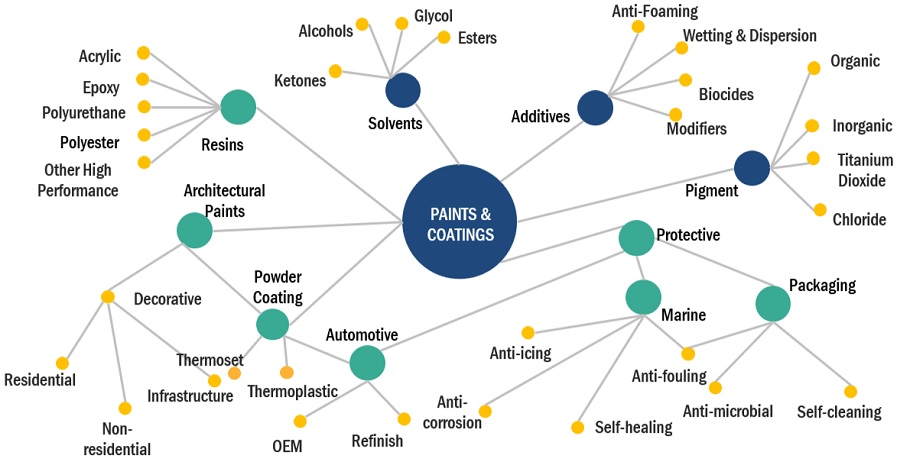
ZnO is the fastest-growing segment in Photocatalytic Coatings market between 2023 and 2028.
ZnO based photocatalytic coatings are very versatile and can by used for different purposes. One of the most important purpose of ZnO NPs is their ability to inhibit the growth of various bacterial and fungal strains, both in solution or on the surfaces. ZnO particles attracted the attention of many researchers due to its applications of UV absorption. Different scientists reported that zinc oxide has attracted much attention for photocatalytic coatings because of its property of high photosensitivity, which causes degradation of various pollutants. ZnO has potential as photocatalyst material because its property of wide band gap. Zinc oxide is an N-type semiconductor with a wide band gap of 3.37 eV and a large exciton binding energy of 60 meV.
Building & Construction is the largest end-use segment in the market of Photocatalytic Coatings between 2023 and 2028.
Buildings and construction is the largest end-use industry of Photocatalytic coatings because in this particular end-use industry the demand for such coatings is required for larger surface areas. There are numerous application areas such as building walls, glass, and metal claddings, historical building protection, fountain, sculpture, industrial facilities, etc. The benefits of these coatings includes the protection from sun’s UV radiation. They use UV radiation along with the oxygen and water vapor present in the air, to create active oxygen ions. The active oxygen ions, in turn, decompose the organic dirt into natural components by an oxidation-reduction reaction which then washed off when it rains.
Asia Pacific is the fastest-growing region in Photocatalytic Coatings market.
Asia Pacific is the fastest growing market for Photocatalytic coatings market. It is the most industrialized and populous region. The building & construction sector in the region is evolving especially in India, China, and other emerging economies which further lead to the increased demand for these coatings. Moreover, after the widespread of COVID-19, every country has taken various measures towards the health of their residents and environment. Consumers are also learning about different coating alternatives that can fight with microbes and does not harm environment leading to rise in opportunities for the given market.
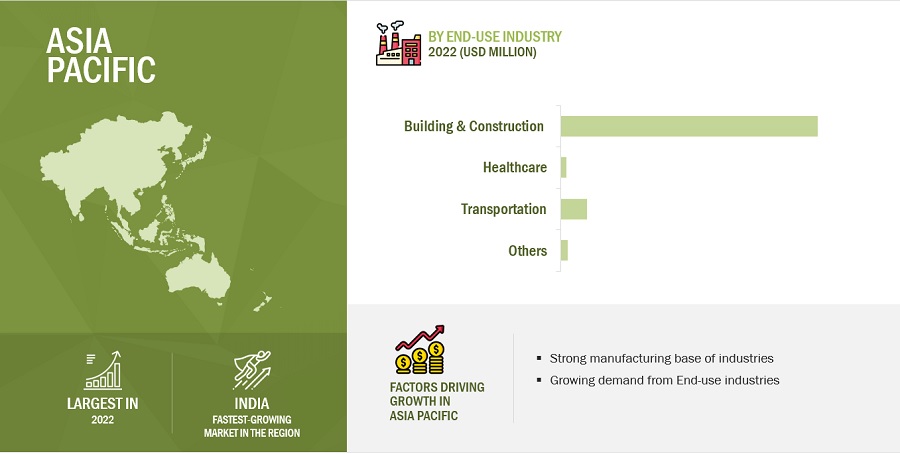
To know about the assumptions considered for the study, download the pdf brochure
Key Market Players
Mitsubishi Chemical Corporation (Japan), Kon Corporation (US), Photocatalytic Coatings Ltd. (New Zealand), USA Nanocoat (US), and Green Millennium (US) are the key players in the global Photocatalytic Coatings market.
Get online access to the report on the World's First Market Intelligence Cloud
- Easy to Download Historical Data & Forecast Numbers
- Company Analysis Dashboard for high growth potential opportunities
- Research Analyst Access for customization & queries
- Competitor Analysis with Interactive dashboard
- Latest News, Updates & Trend analysis
Request Sample Scope of the Report
Get online access to the report on the World's First Market Intelligence Cloud
- Easy to Download Historical Data & Forecast Numbers
- Company Analysis Dashboard for high growth potential opportunities
- Research Analyst Access for customization & queries
- Competitor Analysis with Interactive dashboard
- Latest News, Updates & Trend analysis
|
Report Metric |
Details |
|
Years Considered for the Study |
2021-2028 |
|
Base year |
2022 |
|
Forecast period |
2023–2028 |
|
Units considered |
Value (USD Billion/Million) and Volume (Kiloton) |
|
Segments |
By Type, Application, End-use Industry, and Region |
|
Regions covered |
North America, Europe, Asia Pacific, South America, and Middle East & Africa |
|
Companies profiled |
Mitsubishi Chemical Corporation (Japan), Kon Corporation (US), Saint-Gobain (France), USA Nanocoat (US), and Green Millennium (US). A total of 20 players have been covered. |
This research report categorizes the Photocatalytic coatings market based on type, application, end-use industry, and region.
By Type:
- Titanium dioxide
- Zinc oxide
By Aplication:
- Self-Cleaning
- Air Purification
- Water Treatment
- Anti-Fogging
By End-use Industry:
- Building & Construction
- Healthcare
- Transportation
By Region:
- North America
- Europe
- Asia Pacific
- South America
- Middle East & Africa
Frequently Asked Questions (FAQ):
What are the factors influencing the growth of Photocatalytic Coatings?
The Photocatalytic Coatings market is driven by increasing demand for low VOC emitting coatings.
What are the major applications for Photocatalytic Coatings?
The major applications of Photocatalytic Coatings are self-cleaning, air-purification, water treatment, and anti-fogging.
Which type is gaining popularity for Photocatalytic Coatings?
The ZnO based coatings are gaining popularity at the fastest rate in the Photocatalytic Coatings market.
Who are the major manufacturers?
Mitsubishi Chemical Corporation (Japan), Kon Corporation (US), Saint-Gobain (France), USA Nanocoat (US), and Green Millennium (US) are some of the leading players operating in the global Photocatalytic Coatings market.
Why Photocatalytic Coatings are gaining market share?
The growth of this market is attributed to the different properties of coatings like de-pollution, air purification, anti-fogging effect, and water treatment etc. .
To speak to our analyst for a discussion on the above findings, click Speak to Analyst
The study involves four major activities in estimating the current market size of Photocatalytic coatings. Exhaustive secondary research was done to collect information on the market, peer, and parent markets. The next step was to validate these findings, assumptions, and sizing with industry experts across the value chain through primary research. Both the top-down and bottom-up approaches were employed to estimate the complete market size. After that, the market breakdown and data triangulation methods were used to estimate the size of the segments and sub-segments of the overall market.
Secondary Research
In the secondary research process, various secondary sources, such as Hoovers, Bloomberg BusinessWeek, and Dun & Bradstreet, have been referred to for identifying and collecting information for this study. These secondary sources also included annual reports, press releases & investor presentations of companies; white papers; certified publications; articles by recognized authors; gold standard & silver standard websites; regulatory bodies; trade directories; and databases.
Primary Research
The Photocatalytic coatings market comprises several stakeholders, such as raw material suppliers, end-product manufacturers, and regulatory organizations. The demand side of this market is characterized by the development in end-use industries such as building and construction, healthcare, transportation, etc. Advancements in formulations characterize the supply side. Various primary sources from both the supply and demand sides of the market were interviewed to obtain qualitative and quantitative information.
Following is the breakdown of primary respondents:
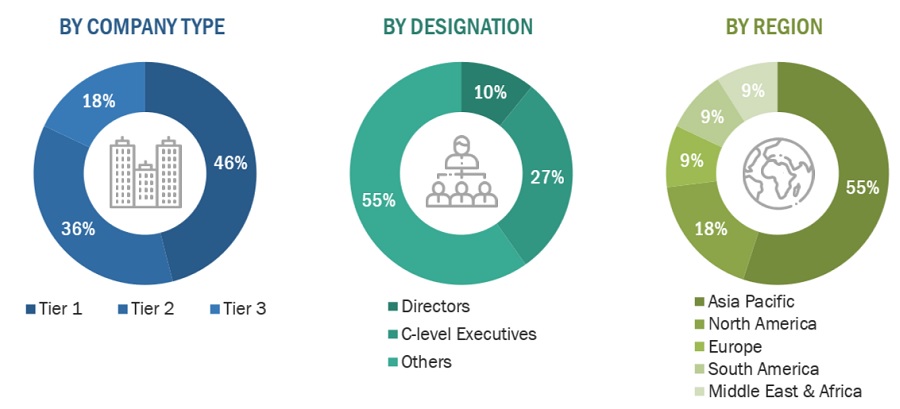
To know about the assumptions considered for the study, download the pdf brochure
Market Size Estimation
Both the top-down and bottom-up approaches were used to estimate and validate the total size of the Photocatalytic coatings market. These methods were also used extensively to estimate the sizes of various sub-segments in the market. The research methodology used to estimate the size of the photocatalytic coatings market includes the following details. The market sizing of the market was undertaken from the demand side. The market was upsized based on procurements and modernizations in Titanium Dioxide, Zinc Oxide and Others at a regional level. Such procurements provide information on the demand aspects of photocatalytic coatings.
Global Photocatalytic coatings Market Size: Bottom-Up Approach
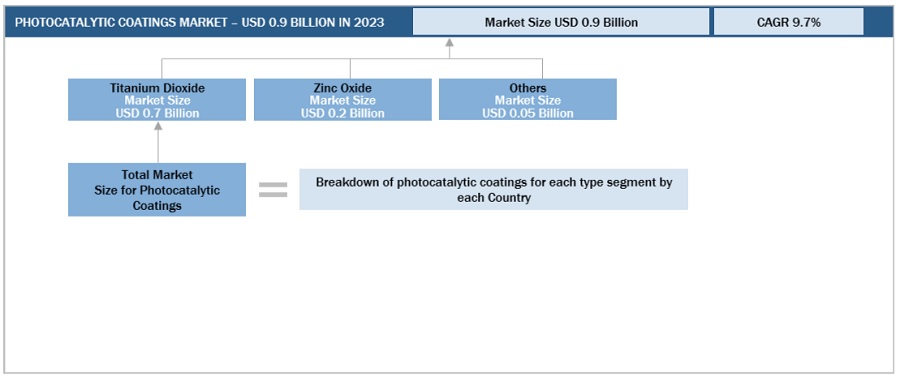
To know about the assumptions considered for the study, Request for Free Sample Report
Global Photocatalytic Coatings Market Size: Top-Down Approach

Data Triangulation
After arriving at the overall size from the market size estimation process explained above, the total market was split into several segments and subsegments. The data triangulation and market breakdown procedures explained below were implemented, wherever applicable, to complete the overall market engineering process and arrive at the exact statistics for various market segments and subsegments. The data was triangulated by studying various factors and trends from the demand and supply sides. Along with this, the market size was validated using both the top-down and bottom-up approaches.
Market Definition
Photocatalytic Coating contains photocatalysts as ingredients which absorb light and catalyze the reaction. The excitation of the photocatalyst causes several reactions at the surface of the coating. This light stimulation of the photocatalyst transforms the properties of the coated surface, creating air purification and self-cleaning properties. Photocatalyst Coatings are transparent and designed for a wide variety of everyday surfaces.
Key Stakeholders
- Manufacturers of Photocatalytic Coatings and their raw materials
- Manufacturers of Photocatalytic Coatings for various end-use industries in sectors such as building & construction, healthcare, transportation, and others
- Traders, Distributors, and Suppliers of Photocatalytic Coatings
- Regional manufacturers’ Associations and Photocatalytic Coatings Associations
- Government and Regional Agencies and Research Organizations
Report Objectives
- To analyze and forecast the size of the Photocatalytic coatings market in terms of value and volume
- To define, describe, and forecast the Photocatalytic coatings market by type, application, end-use industry, and region
- To provide detailed information about the drivers, restraints, opportunities, and challenges influencing the growth of the market
- To forecast the market size of the Photocatalytic coatings market concerning the five major region i.e., North America, Europe, Asia Pacific, South America, and Middle East & Africa
- To strategically analyze micromarkets1 with respect to individual growth trends, growth prospects, and their contribution to the overall market
- To analyze the opportunities in the market for stakeholders and provide a competitive landscape for the market leaders
- To analyze competitive developments, such as mergers & acquisitions, new product launches, and investments & expansions, in the Photocatalytic coatings market
- To strategically profile key players and comprehensively analyze their market shares and core competencies2
Note: 1. Micromarkets are defined as the sub-segments of the Photocatalytic coatings market included in the report.
Note 2: Core competencies of the companies are captured in terms of their key developments and key strategies adopted to sustain their position in the market.
Available Customizations
MarketsandMarkets offers customizations according to the specific needs of the companies with the given market data.
The following customization options are available for the report:
Product Analysis
- Product matrix, which gives a detailed comparison of the product portfolio of each company
Regional Analysis
- Further breakdown of the Photocatalytic coatings market, by region
Company Information
- Detailed analysis and profiling of additional market players (up to five)












Growth opportunities and latent adjacency in Photocatalytic Coatings Market